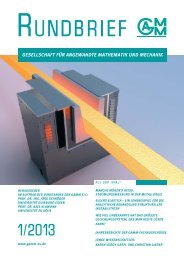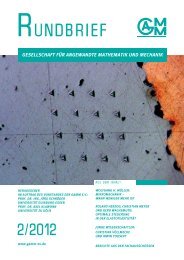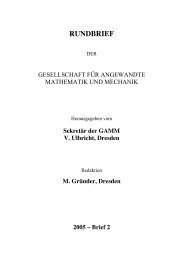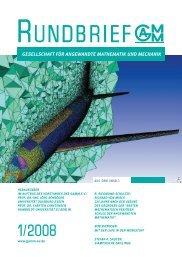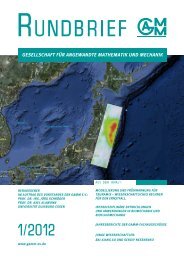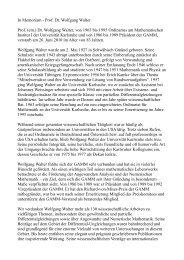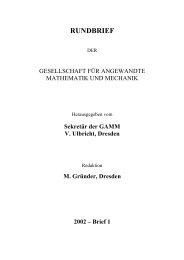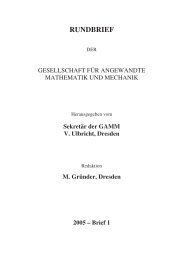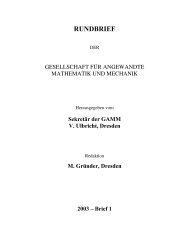GAMM Rundbrief 2010/Heft 1
GAMM Rundbrief 2010/Heft 1
GAMM Rundbrief 2010/Heft 1
Erfolgreiche ePaper selbst erstellen
Machen Sie aus Ihren PDF Publikationen ein blätterbares Flipbook mit unserer einzigartigen Google optimierten e-Paper Software.
Stochastische FEM und Numerik stochastischer partieller Differential-gleichungen<br />
[14] I. Doltsinis. Inelastic deformation processes with random parameters – methods<br />
of analysis and design. Comput. Methods Appl. Mech. Engrg., 192:2405-<br />
2423, 2003<br />
[15] I. Elishakoff (ed.). Whys and Hows in Uncertainty Modelling - Probability,<br />
Fuzziness, and Anti-Optimization. Springer Verlag, Berlin, 1999<br />
[16] Ph. Frauenfelder, Chr. Schwab, R. A. Todor. Finite elements for elliptic problems<br />
with stochastic coefficients. Comp. Meth. Appl. Mech. Engrg., 194:205-<br />
228, 2005<br />
[17] R. Ghanem, P. D. Spanos. Stochastic Finite Elements - A Spectral Approach.<br />
Springer Verlag, Berlin, 1991<br />
[18] R. Ghanem, R. Kruger. Numerical solution of spectral stochastic finite element<br />
systems. Comp. Meth. Appl. Mech. Engrg.,129:289-303, 1999<br />
[19] M. A. Gutiérrez, S. Krenk. Stochastic finite element methods. In: E. Stein, R. de<br />
Borst, T. R. J. Hughes (eds.), Encyclopedia of Computational Mechanics, Vol.<br />
2:657-681. John Wiley & Sons, Chichester, 2007.<br />
[20] T. Hida, H.-H. Kuo, J. Potthoff, and L. Streit. White Noise - An Infinite Dimensional<br />
Calculus. Kluwer, Dordrecht, 1993<br />
[21] J. Hadamard. Sur les problèmes aux dérivée partielles et leur signification<br />
physique. Princeton University Bulletin 13:49-52, 1902<br />
[22] R. Helmig, W. Jäger, W. Kinzelbach. Modelling and Computation in Environmental<br />
Sciences. Vieweg Verlag, Braunschweig, 1997<br />
[23] H. Holden, B. Øksendal, J. Ubøe, T.-S. Zhang. Stochastic Partial Differential<br />
Equations. Birkhäuser Verlag, Basel, 1996<br />
[24] K. Itô. Foundations of Stochastic Differential Equqations in Infinite Dimensions.<br />
Siam, Philadelphia, 1984<br />
[25] S. Janson. Gaussian Hilbert Spaces. Cambridge University Press, Cambridge,<br />
1997<br />
[26] E. T. Jaynes. Probability Theory, the Logic of Science. Cambridge University<br />
Press, Cambridge, 2003.<br />
[27] M. Jardak, C.-H. Su, G. E. Karniadakis. Spectral polynomial chaos solutions<br />
of the stochastic advection equation. SIAM J. Sci. Comput., 17:319-338, 2002<br />
[28] K. Karhunen. Über lineare Methoden in der Wahrscheinlichkeitsrechnung.<br />
Ann. Acad. Sc. Fen. Ser. A., 37:1-79, 1947<br />
[29] G. E. Karniadakis, C.-H. Sue, D. Xiu, D. Lucor, C. Schwab, R. A.Tudor. Generalized<br />
polynomial chaos solution for differential equations with random input.<br />
Research Report 2005-1, SAM, ETH Zürich, 2005<br />
[30] A. Keese. A review of recent developments in the numerical solution of stochastic<br />
PDEs (stochastic finite elements). Informatikbericht 2003-6, Institute<br />
of Scientific Computing, Technische Universität Braunschweig, 2003.<br />
http://opus.tu-bs.de/ opus/volltexte/ 2003/504<br />
[31] A. Keese, H. G. Matthies. Efficient solvers for nonlinear stochastic problems.<br />
In: Proceedings of WCCM V - 5th World Congress Comput. Mech., Vienna,<br />
7-12 July 2002. http://wccm.tuwien.ac.at<br />
[32] A. Keese, H. G. Matthies. Parallel solution methods for stochastic systems. In<br />
K.-J. Bathe (ed.), Computational Fluid and Solid Mechanics - Proceedings of<br />
the 2nd MIT conference. Elsevier, Amsterdam, 2003. pp 2023-2025<br />
[33] A. Keese, H. G. Matthies. Adaptivity and sensitivity for stochastic problems.<br />
In: P. D. Spanos and G. Deodatis (eds.), Computational Stochastic Mechanics<br />
4. Millpress, Rotterdam, 311-316, 2003<br />
[34] M. Kleiber , T. D. Hien. The Stochastic Finite Element Method. Basic Perturbation<br />
Technique and Computer Implementation. John Wiley & Sons, Chichester,<br />
1992<br />
[35] P. E. Kloeden, E. Platen. Numerical Solution of Stochastic Differential Equations.<br />
Springer Verlag, Berlin, 1995<br />
[36] P. Krée, C. Soize. Mathematics of Random Phenomena. D. Reidel, Dordrecht,<br />
1986<br />
[37] 67 O. P. LeMaître, O. M. Knio, H. N. Najm, R. G. Ghanem. Uncertainty propagation<br />
using Wiener-Haar expansions. J. Comput. Phys. 197:28-57, 2004<br />
[38] O. P. LeMaître, H. N. Najm, R. G. Ghanem, O. M. Knio. Multi-resolution<br />
analysis of Wiener-type uncertainty propagation schemes. J. Comput. Phys.,<br />
197:502-531, 2004<br />
[39] D. Liu. Uncertainty Quantification with Shallow Water Equations. Dissertation<br />
an der TU Braunschweig, 2009<br />
[40] P. Malliavin. Stochastic Analysis. Springer Verlag, Berlin, 1997<br />
[41] H. G. Matthies, C. E. Brenner, C. G. Bucher, C. Guedes Soares. Uncertainties<br />
in probabilistic numerical analysis of structures and solids-stochastic finite<br />
elements. Struct. Safety 19:283-336, 1997<br />
[42] H. G. Matthies, C. G. Bucher. Finite elements for stochastic media problems.<br />
Comp. Meth. Appl. Mech. Engrg., 168:3-17, 1999<br />
[43] H. G. Matthies, A. Keese. Galerkin methods for linear and nonlinear elliptic<br />
stochastic partial differential equations. Comp. Meth. Appl. Mech. Engrg.,<br />
194:1295-1331, 2005<br />
[44] H. G. Matthies. Computational aspects of probability in non-linear mechanics.<br />
In: A. Ibrahimbegoviç, B. Brank (eds.), Engineering Structures under Extreme<br />
Conditions. NATO Science Series III: Computer and System Sciences<br />
Vol.194, IOS Press, Amsterdam, 2005<br />
[45] H. G. Matthies: Quantifying Uncertainty: Modern Computational Representation<br />
of Probability and Applications. In: A. Ibrahimbegoviç, I. Kožar (eds.), Extreme<br />
Man-Made and Natural Hazards in Dynamics of Structures. Springer<br />
Verlag, Berlin, 2007<br />
[46] H. G. Matthies. Uncertainty Quantification with Stochastic Finite Elements.<br />
In: E. Stein, R. de Borst, T. R. J. Hughes (eds.), Encyclopedia of Computational<br />
Mechanics, John Wiley & Sons, Chichester, 2007.<br />
[47] H.G. Matthies. Stochastic finite elements: Computational approaches to stochastic<br />
partial differential equations. Zeitschrift für Angewandte Mathematik<br />
und Mechanik (ZAMM). 88:849-873, 2008<br />
[48] H. G. Matthies, B. Rosiç: Inelastic Media under Uncertainty: Stochastic Models<br />
and Computational Approaches. In: D. Reddy (ed.), IUTAM Symposium<br />
on Theoretical, Computational, and Moddeling Aspects of Inelasic Media.<br />
Cape Town, January 2008, Springer Verlag, Berlin, 2008<br />
[49] R. E. Melchers. Structural Reliability Analysis and Prediction. John Wiley &<br />
Sons, Chichester, 1999<br />
[50] B. Möller, M. Beer. Fuzzy Randomness. Uncertainty in Civil Engineering and<br />
Computational Mechanics. Springer Verlag, Berlin, 2004<br />
[51] H. G. Natke, Y. Ben-Haim (eds.). Uncertainty: Models and Measures. Akademie-Verlag,<br />
Berlin, 1997<br />
[52] F. Nobile, R. Tempone, C. G. Webster. Sparse grid stochastic collocation method<br />
for elliptic partial differential equations with random input data. preprint,<br />
2006.<br />
[53] B. Øksendal. Stochastic Differential Equations. Springer Verlag, Berlin, 2003<br />
[54] L. J. Roman, M. Sarkis, Stochastic Galerkin Method for Elliptic SPDEs: A<br />
White Noise Approach, Discrete Contin. Dyn. System. B 6: 941-955, 2006<br />
[55] Y. Rozanov. Random Fields and Stochastic Partial Differential Equations. Kluwer,<br />
Dordrecht, 1996<br />
[56] K. K. Sabelfeld. Monte Carlo Methods in Boundary Value Problems. Springer<br />
Verlag, Berlin, 1991<br />
[57] G. I. Schuëller. A state-of-the-art report on computational stochastic mechanics.<br />
Prob. Engrg. Mech. 14:197-321, 1997<br />
[58] G. I. Schuëller. Recent developments in structural computational stochastic<br />
mechanics. In: B. H. V.Topping (ed.), Computational Mechanics for the<br />
Twenty-First Century. Saxe-Coburg Publications, Edinburgh, 2000<br />
[59] G. I. Schuëller, P. D. Spanos (eds.).Monte Carlo Simulation. Balkema, Rotterdam,<br />
2001.<br />
[60] B. Sudret, A. Der Kiureghian. Stochastic finite element methods and reliability.<br />
A state-of-the-art report. Report UCB/SEMM-2000/08, Department<br />
of Civil & Environmental Engineering, University of California, Berkeley, CA,<br />
2000<br />
[61] X. Wan, G. E. Karniadakis. An adaptive multi-element generalized polynomial<br />
chaos method for stochastic differential equations. J. Comput. Phys,<br />
209:617-642, 2005<br />
[62] N. Wiener: The homogeneous chaos. Amer. J. Math. 60:897-936, 1938<br />
[63] D. Xiu, G. E. Karniadakis. The Wiener-Askey polynomial chaos for stochastic<br />
differential equations. SIAM J. Sci. Comput. 24:619-644, 2002<br />
[64] D. Xiu, G. E. Karniadakis. Modeling uncertainty in flow simulations via generalized<br />
polynomial chaos. J. Comp. Phys., 187:137-167, 2003<br />
[65] D. Xiu, J. S. Hesthaven. High order collocation methods for differential equations<br />
with random inputs. SIAM J. Sci. Comput., 27:1118-1139, 2005<br />
[66] D. Xiu, D. Lucor, C.-H. Su, G. E. Karniadakis. Stochastic modeling of flowstructure<br />
interactions using generalized polynomial chaos. ASME J. Fluid<br />
Eng. 124:51-69, 2002<br />
[67] E. Zander, H. G. Matthies. Tensor product methods for stochastic problems.<br />
Proceedings in Applied Mathematics and Mechanics (PAMM), 7: 2040067-<br />
2040068, 2007<br />
[68] E. Zander, H. G. Matthies. Low -rank tensor product solvers. Nov. 2009 eingereicht<br />
bei Linear Algebra and its Applications (LAA)<br />
Hermann Matthies studierte 1971-1976 Mathematik mit Nebenfach Informatik, Physik und Ingenieurwissenschaften<br />
an der TU Berlin. Die Promotion im Fach Mathematik am Massachusetts Institute of Technology, Cambridge, USA, erfolgte im<br />
Jahre 1978. Von 1979 bis 1995 war er in verschiedenen Funktionen für den Germanischen Lloyd in Hamburg tätig, vor allem in den<br />
Bereichen Forschung, Windenergie und Offshore. Im Jahre 1995 wurde er zum Leiter des an der TU Braunschweig neu gegründeten<br />
Instituts für Wissenschaftliches Rechnen berufen. Hermann Matthies arbeitet an verschiedenen Forschungsvorhaben im Bereich des<br />
Wissenschaftlichen Rechnens, meist mit Anwendungen in den Natur- und Ingenieurwissenschaften zusammen mit nationalen und<br />
internationalen Partnern. Sein besonderes Interesse gilt zur Zeit gekoppelten Problemen und der numerischen Stochastik. Er hielt<br />
sich zu längeren Forschungsaufenthalten im Ausland auf, darunter an der École Normale Supérieure (ENS) Cachan in Paris, Frankreich,<br />
am Institute for Computational Engineering and Sciences (ICES) an der University of Texas at Austin, USA, an der University<br />
of Queensland, Brisbane, Australien, und an der Lincoln University, Christchurch, Neuseeland.<br />
<strong>Rundbrief</strong> 1/<strong>2010</strong><br />
11



